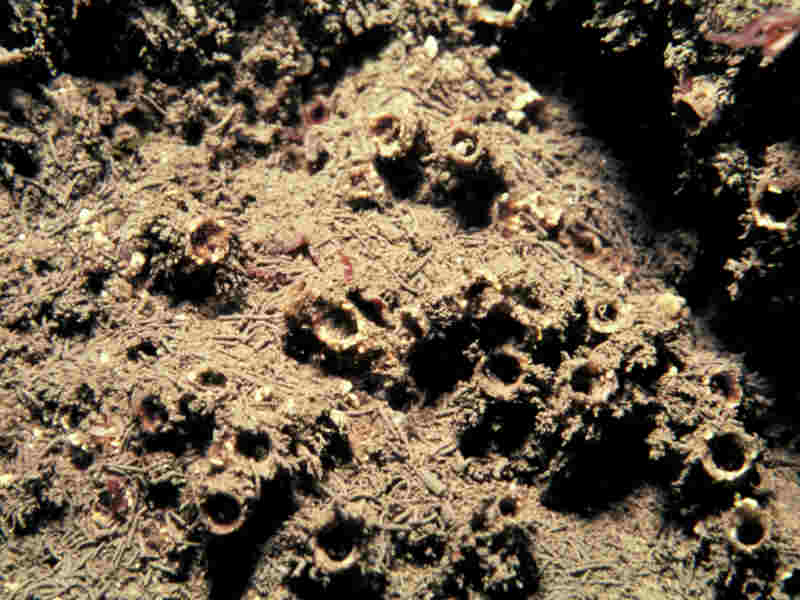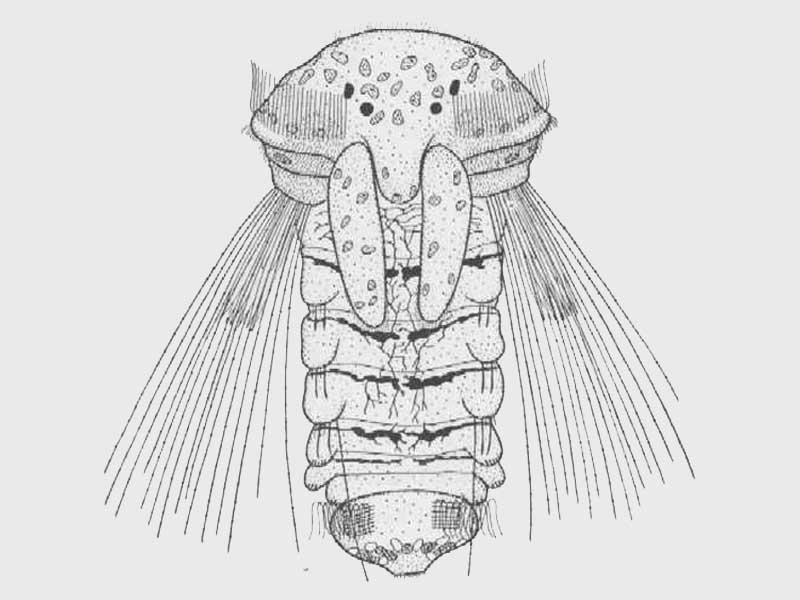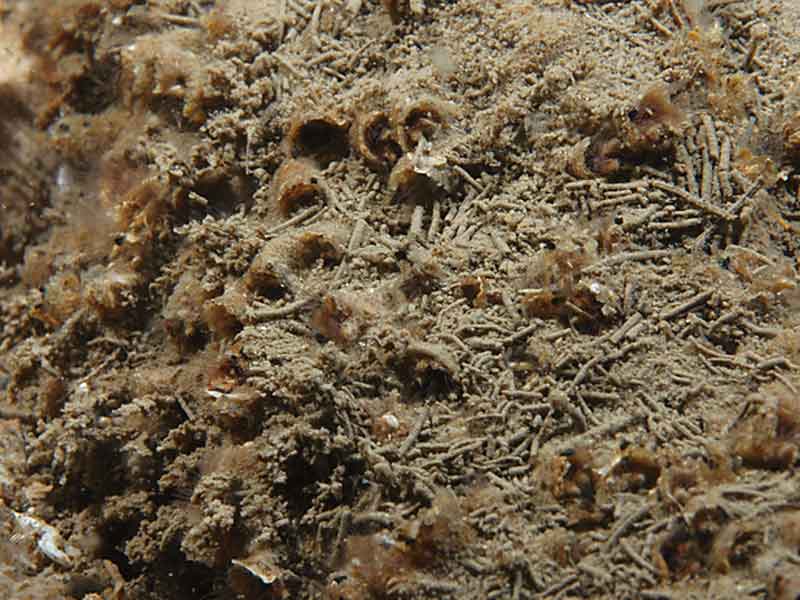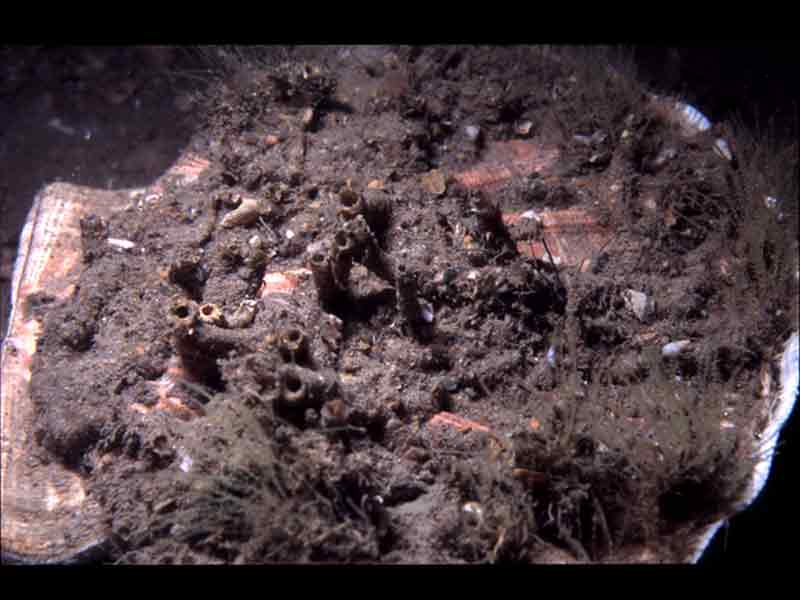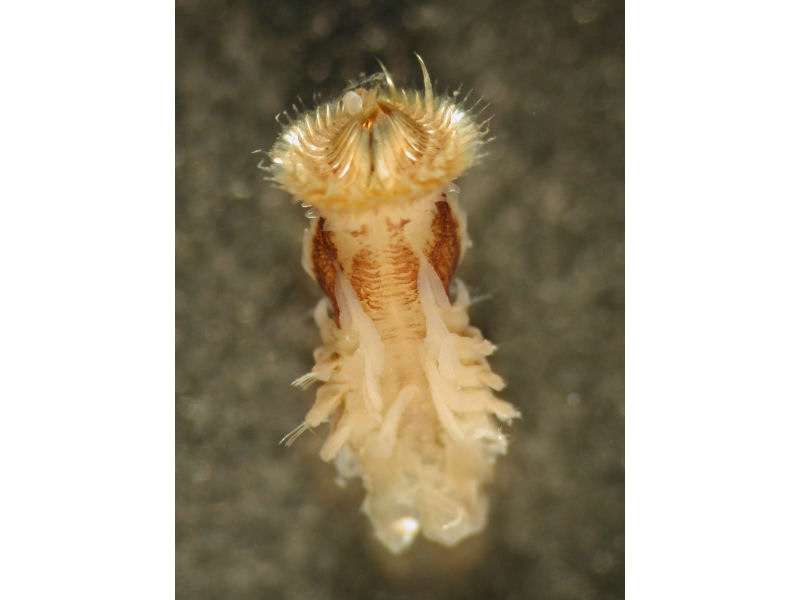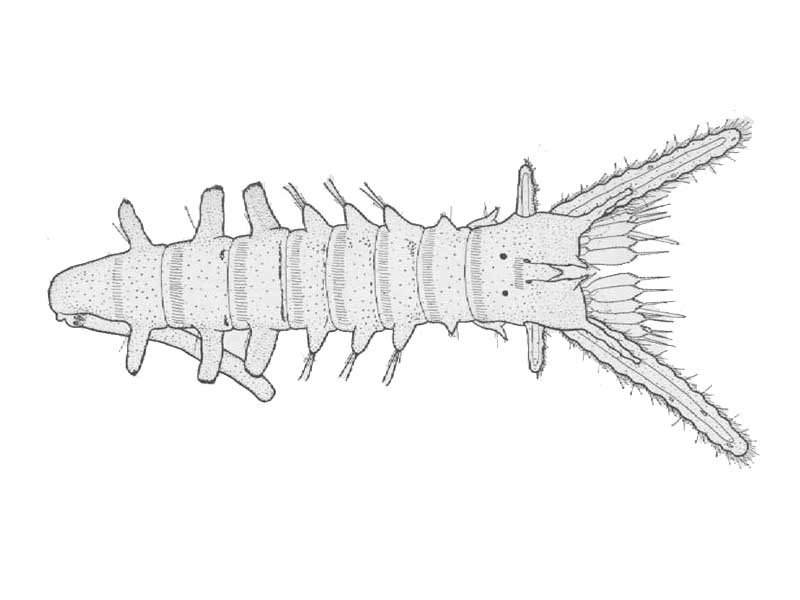Ross worm (Sabellaria spinulosa)
Distribution data supplied by the Ocean Biodiversity Information System (OBIS). To interrogate UK data visit the NBN Atlas.Map Help
| Researched by | Angus Jackson & Dr Keith Hiscock | Refereed by | Prof. Steve J. Hawkins |
| Authority | (Leuckart, 1849) | ||
| Other common names | - | Synonyms | - |
Summary
Description
An occasionally gregarious segmented worm that builds tubes from sand or shell fragments. Found subtidally in exposed areas. Does not form reefs over most of its range being found mostly individually but may form thin crusts or large reefs up to several metres across and 60 cm high. Quite similar to Sabellaria alveolata.
Recorded distribution in Britain and Ireland
All British and Irish coastsGlobal distribution
Arctic, North Sea, Channel, AtlanticHabitat
Found on hard substrata on exposed, open coasts where sand is available for tube building. It is mainly subtidal but may be found in the low intertidal.Depth range
-Identifying features
- Inhabits a tube with round straight opening made from coarse, cemented sand or shell grains.
- Thorax with three pairs of flattened chaetal sheaths.
- Opercular chaetae in middle row point distally.
- Outer row chaetae taper with several serrations on either side.
Additional information
At low densities, the tubes are attached to the substratum along the entire length but at greater densities competition for space results in the tubes overlapping and may cause the tubes to be built outwards, away from the substratum.
Listed by
- none -
Biology review
Taxonomy
| Level | Scientific name | Common name |
|---|---|---|
| Phylum | Annelida | Segmented worms e.g. ragworms, tubeworms, fanworms and spoon worms |
| Class | Polychaeta | Bristleworms, e.g. ragworms, scaleworms, paddleworms, fanworms, tubeworms and spoon worms |
| Family | Sabellariidae | |
| Genus | Sabellaria | |
| Authority | (Leuckart, 1849) | |
| Recent Synonyms | ||
Biology
| Parameter | Data | ||
|---|---|---|---|
| Typical abundance | High density | ||
| Male size range | 20 - 30mm | ||
| Male size at maturity | |||
| Female size range | Small-medium(3-10cm) | ||
| Female size at maturity | |||
| Growth form | Tubicolous | ||
| Growth rate | Field unresearched | ||
| Body flexibility | |||
| Mobility | |||
| Characteristic feeding method | Active suspension feeder | ||
| Diet/food source | |||
| Typically feeds on | Phytoplankton | ||
| Sociability | |||
| Environmental position | Epifaunal | ||
| Dependency | Independent. | ||
| Supports | Substratum a variety of organisms. Forms a substratum for algae and shelter for small crabs etc. (particularly when forming reefs or crusts) | ||
| Is the species harmful? | No | ||
Biology information
Can be found in very high densities, for example when forming a reef. Typically found in lower densities as a crust or as individuals. At the Bristol Channel location studied by George & Warwick (1986), densities in excess of 4,000/m² for loosely aggregated Sabellaria spinulosa were recorded whilst the area sampled by Hiscock & Rostron (unpublished) on a level hard substratum had a single layer crust with 9,561 individual Sabellaria spinulosa in 1.4m². There has been considerable concern about decline in Sabellaria spinulosa reefs and shrimp fisheries have been implicated in the decline. However, Vorberg (2000) could find no damage caused after experiments with shrimp trawls in the Wadden Sea and suggests that declines might be more associated with changing patterns of currents perhaps associated with construction, dredging and dumping.
Habitat preferences
| Parameter | Data |
|---|---|
| Physiographic preferences | Open coast, Offshore seabed |
| Biological zone preferences | Lower infralittoral, Upper infralittoral |
| Substratum / habitat preferences | Bedrock, Cobbles, Large to very large boulders, Small boulders |
| Tidal strength preferences | Moderately strong 1 to 3 knots (0.5-1.5 m/sec.), Strong 3 to 6 knots (1.5-3 m/sec.) |
| Wave exposure preferences | Exposed, Moderately exposed, Very exposed |
| Salinity preferences | Full (30-40 psu) |
| Depth range | |
| Other preferences | No text entered |
| Migration Pattern | Non-migratory or resident |
Habitat Information
Often settles on Pecten maximus and Buccinum undatum and occasionally on Aequipecten opercularis. Has strong settlement preference for tubes or sites currently or previously used by the species.Life history
Adult characteristics
| Parameter | Data |
|---|---|
| Reproductive type | Gonochoristic (dioecious) |
| Reproductive frequency | Annual protracted |
| Fecundity (number of eggs) | No information |
| Generation time | Insufficient information |
| Age at maturity | |
| Season | January - March |
| Life span | 2-5 years |
Larval characteristics
| Parameter | Data |
|---|---|
| Larval/propagule type | - |
| Larval/juvenile development | Planktotrophic |
| Duration of larval stage | 1-2 months |
| Larval dispersal potential | Greater than 10 km |
| Larval settlement period | March |
Life history information
Wilson (1970b) stated that the larvae spend between six weeks and two months in the plankton. Reproductive seasonality is unclear but George & Warwick (1985) and Wilson (1970) have both reported larval settlement in March in the Bristol Channel and Plymouth areas respectively. Wilson (1970) found a spawning period from January to March in Plymouth. Possibly has similar lifespan to Sabellaria alveolata (up to 9 years). Fecundity and recruitment may be variable (Holt et al., 1998) but may be similar to Sabellaria alveolata.Sensitivity review
The MarLIN sensitivity assessment approach used below has been superseded by the MarESA (Marine Evidence-based Sensitivity Assessment) approach (see menu). The MarLIN approach was used for assessments from 1999-2010. The MarESA approach reflects the recent conservation imperatives and terminology and is used for sensitivity assessments from 2014 onwards.
Physical pressures
Use / to open/close text displayed
| Intolerance | Recoverability | Sensitivity | Evidence / Confidence | |
Substratum loss [Show more]Substratum lossBenchmark. All of the substratum occupied by the species or biotope under consideration is removed. A single event is assumed for sensitivity assessment. Once the activity or event has stopped (or between regular events) suitable substratum remains or is deposited. Species or community recovery assumes that the substratum within the habitat preferences of the original species or community is present. Further details EvidenceThe species is fixed to the substratum so substratum removal will cause mortality. Recruitment rates are high and recovery could be quite rapid (see additional information). It is often one of the first species to settle on new substrata. | High | High | Moderate | High |
Smothering [Show more]SmotheringBenchmark. All of the population of a species or an area of a biotope is smothered by sediment to a depth of 5 cm above the substratum for one month. Impermeable materials, such as concrete, oil, or tar, are likely to have a greater effect. Further details. EvidenceExtrapolating from Sabellaria alveolata it is probable that Sabellaria spinulosa can tolerate smothering by sediment for up to several weeks. Feeding and growth will be curtailed. Depending on timing this may interfere with reproduction. Recovery would be almost immediate. | Low | Immediate | Not sensitive | Moderate |
Increase in suspended sediment [Show more]Increase in suspended sedimentBenchmark. An arbitrary short-term, acute change in background suspended sediment concentration e.g., a change of 100 mg/l for one month. The resultant light attenuation effects are addressed under turbidity, and the effects of rapid settling out of suspended sediment are addressed under smothering. Further details EvidenceTube growth is dependent on the presence of suspended particles, hence increase in suspended sediment could facilitate tube construction and may result in increased populations. However, an increase in siltation may also clog feeding apparatus - assumed here. Recovery occurs when the population is able to recommence feeding and growing. | Low | Immediate | Not sensitive | Moderate |
Decrease in suspended sediment [Show more]Decrease in suspended sedimentBenchmark. An arbitrary short-term, acute change in background suspended sediment concentration e.g., a change of 100 mg/l for one month. The resultant light attenuation effects are addressed under turbidity, and the effects of rapid settling out of suspended sediment are addressed under smothering. Further details EvidenceTube growth is dependent on the presence of suspended particles, hence a reduction in siltation may hinder tube construction and/or may favour other species to compete sucessfully with Sabellaria spinulosa. Overall, a decline in population density seems likely. Recovery would be high (see additional information). | Intermediate | High | Low | Moderate |
Desiccation [Show more]Desiccation
EvidenceThe species is sessile and typically subtidal but is also occasionally found intertidally and so can be exposed to drying influences. If exposed to the air the worm can retract into its tube and close the operculum over the entrance reducing evaporation. | Tolerant | Not relevant | Not sensitive | Low |
Increase in emergence regime [Show more]Increase in emergence regimeBenchmark. A one hour change in the time covered or not covered by the sea for a period of one year. Further details EvidenceThe species is sessile and typically subtidal but is also occasionally found in the low intertidal. This means the species can tolerate some emergence, however, increased emergence will reduce the amount of time available for feeding. This species is more subtidal than Sabellaria alveolata. Variability in recruitment (dependent on suitable environmental conditions) means that recovery could be quite rapid, say a year, or take several years. The presence of some remaining adults will assist in larval settlement as this is the preferred substratum (Wilson, 1929). | Intermediate | High | Low | Low |
Decrease in emergence regime [Show more]Decrease in emergence regimeBenchmark. A one hour change in the time covered or not covered by the sea for a period of one year. Further details EvidenceThe species is sessile and typically subtidal but is also occasionally found in the low intertidal. The species is likely to benefit from decrease in emergence. | Tolerant* | Not relevant | Not sensitive* | High |
Increase in water flow rate [Show more]Increase in water flow rateA change of two categories in water flow rate (view glossary) for 1 year, for example, from moderately strong (1-3 knots) to very weak (negligible). Further details EvidenceThe species occurs in areas with high water flow so an increase in rate is likely to have little effect on attached individuals. However, Sabellaria spinulosa typically inhabits cobbles and pebbles that are likely to become mobile if water flow rate is increased and therefore result in scour and mortality of individuals. Not all individuals are likely to be killed and an intolerance of intermediate is suggested. High levels of recruitment means that recovery could be quite rapid, say within a year (see additional information). The presence of some remaining adults will assist in larval settlement as this is the preferred substratum (Wilson, 1929). | Intermediate | High | Low | Low |
Decrease in water flow rate [Show more]Decrease in water flow rateA change of two categories in water flow rate (view glossary) for 1 year, for example, from moderately strong (1-3 knots) to very weak (negligible). Further details EvidenceThe species inhabits areas with high water flow so an increase in rate is likely to have little effect. A reduction of water flow by two categories is likely to cause exposure to conditions outside the normal range for the species. This may be sufficient to reduce availability of suspended particles, hindering growth and repair and feeding. High levels of recruitment means that recovery could be quite rapid, say within a year (see additional information). The presence of some remaining adults will assist in larval settlement as this is the preferred substratum (Wilson, 1929). | Intermediate | High | Low | Moderate |
Increase in temperature [Show more]Increase in temperature
For intertidal species or communities, the range of temperatures includes the air temperature regime for that species or community. Further details EvidenceThe species does appear to thrive in conditions of cold water (for instance, it extends into arctic areas) and long-term increase in temperature may have a negative effect so that populations do not thrive. The species is highly fecund and likely to recover quickly from short-term declines that might be due to increased temperatures (see additional information). | Low | High | Low | Very low |
Decrease in temperature [Show more]Decrease in temperature
For intertidal species or communities, the range of temperatures includes the air temperature regime for that species or community. Further details EvidenceSabellaria spinulosa did not appear to suffer mortality during the 1963-64 winter (Crisp, 1964). The species occurs north to the arctic and is therefore considered tolerant of decrease in temperature. | Tolerant | Not relevant | Not sensitive | High |
Increase in turbidity [Show more]Increase in turbidity
EvidenceSabellaria spinulosa thrives in turbid water conditions and has no reliance on visual sense for feeding, reproducing etc. | Tolerant | Not relevant | Not sensitive | Low |
Decrease in turbidity [Show more]Decrease in turbidity
EvidenceDecrease in turbidity may be sufficient to reduce availability of suspended particles, hindering growth, repair and feeding. Effects are likley to be sublethal in the short-term but may reduce viability of populations and result in decline if the turbidity decrease is chronic. The species is highly fecund and likely to recover quickly from short-term declines that might be due to increased temperatures (see additional information). | Intermediate | High | Low | Low |
Increase in wave exposure [Show more]Increase in wave exposureA change of two ranks on the wave exposure scale (view glossary) e.g., from Exposed to Extremely exposed for a period of one year. Further details EvidenceWhere the species exists as loose crusts, death may occur through break-up due to wave action. Increased wave action may also mobilize the pebble and gravel substrata on which Sabellaria spinulosa often occurs resulting in abrasion and mortality. High levels of recruitment means that recovery could be quite rapid, say within a year (see additional information). The presence of some remaining adults will assist in larval settlement as this is the preferred substratum (Wilson, 1929). | Intermediate | High | Low | Moderate |
Decrease in wave exposure [Show more]Decrease in wave exposureA change of two ranks on the wave exposure scale (view glossary) e.g., from Exposed to Extremely exposed for a period of one year. Further details EvidenceWave action may be required, in the absence of strong tidal flow, to suspend the coarse sand particles needed to build tubes. Reduced wave action may mean the population exists outside of its preferred conditions with insufficient water action to provide sand particles or food. Some reduction in the population therefore seems likely. High levels of recruitment means that recovery could be quite rapid, say within a year (see additional information). The presence of some remaining adults will assist in larval settlement as this is the preferred substratum (Wilson, 1929). | Intermediate | High | Low | |
Noise [Show more]Noise
EvidenceThe species is unlikely to respond to noise vibrations | Tolerant | Not relevant | Not sensitive | Low |
Visual presence [Show more]Visual presenceBenchmark. The continuous presence for one month of moving objects not naturally found in the marine environment (e.g., boats, machinery, and humans) within the visual envelope of the species or community under consideration. Further details EvidenceMost polychaetes have photoreceptors but the species is probably unable to resolve moving objects. The worms may retract into tube on disturbance. Whether this is through light detection or mechanical stimulus is uncertain. | Tolerant | Not relevant | Not sensitive | Low |
Abrasion & physical disturbance [Show more]Abrasion & physical disturbanceBenchmark. Force equivalent to a standard scallop dredge landing on or being dragged across the organism. A single event is assumed for assessment. This factor includes mechanical interference, crushing, physical blows against, or rubbing and erosion of the organism or habitat of interest. Where trampling is relevant, the evidence and trampling intensity will be reported in the rationale. Further details. EvidenceExtrapolating from Sabellaria alveolata it is probable that Sabellaria spinulosa is quite tolerant to abrasion resulting from trawling. The ability of Sabellaria alveolata to repair tubes is well developed (Cunningham et al., 1984; Vorberg, 2000). However, abrasion resulting from substratum (cobbles and pebbles) becoming mobile is likely to cause significant damage. High levels of recruitment means that recovery could be quite rapid, say within a year (see additional information). The presence of some remaining adults will assist in larval settlement as this is the preferred substratum (Wilson, 1929). | Intermediate | High | Low | Low |
Displacement [Show more]DisplacementBenchmark. Removal of the organism from the substratum and displacement from its original position onto a suitable substratum. A single event is assumed for assessment. Further details EvidenceWorms are not able to rebuild tubes if removed from them (Wilson, 1929). High levels of recruitment means that recovery could be quite rapid, say within a year (see additional information). The presence of some remaining adults will assist in larval settlement as this is the preferred substratum (Wilson, 1929). | High | High | Moderate | Low |
Chemical pressures
Use [show more] / [show less] to open/close text displayed
| Intolerance | Recoverability | Sensitivity | Evidence / Confidence | |
Synthetic compound contamination [Show more]Synthetic compound contaminationSensitivity is assessed against the available evidence for the effects of contaminants on the species (or closely related species at low confidence) or community of interest. For example:
The evidence used is stated in the rationale. Where the assessment can be based on a known activity then this is stated. The tolerance to contaminants of species of interest will be included in the rationale when available; together with relevant supporting material. Further details. EvidenceAlthough the larvae are known to be highly intolerant of some oil dispersants, Sabellaria spinulosa has been found to thrive in polluted areas. In particular in an area with acidified halogenated effluent. It is found at higher densities near the effluent than elsewhere through the exclusion of other species (Hoare & Hiscock, 1974). The species has been assessed as tolerant* by extrapolating from these observations. It may well be that Sabellaria spinulosa has different sensitivities to other synthetic chemicals but this information is not available. | Tolerant* | Not relevant | Not sensitive* | Moderate |
Heavy metal contamination [Show more]Heavy metal contaminationEvidenceInsufficientinformation | No information | No information | No information | Not relevant |
Hydrocarbon contamination [Show more]Hydrocarbon contaminationEvidenceInsufficientinformation | No information | No information | No information | Not relevant |
Radionuclide contamination [Show more]Radionuclide contaminationEvidenceInsufficientinformation | No information | No information | No information | Not relevant |
Changes in nutrient levels [Show more]Changes in nutrient levelsEvidenceInsufficientinformation | No information | No information | No information | Not relevant |
Increase in salinity [Show more]Increase in salinity
Evidence | No information | Not relevant | No information | Not relevant |
Decrease in salinity [Show more]Decrease in salinity
EvidenceThe species only occurs in fully marine environment, however, as it does occasionally occur in the intertidal, it must be able to tolerate some reduced salinity caused by precipitation run off. High levels of recruitment means that recovery could be quite rapid, say within a year (see additional information). The presence of some remaining adults will assist in larval settlement as this is the preferred substratum (Wilson, 1929). | Intermediate | High | Low | Moderate |
Changes in oxygenation [Show more]Changes in oxygenationBenchmark. Exposure to a dissolved oxygen concentration of 2 mg/l for one week. Further details. EvidenceCole et al. (1999) suggest possible adverse effects on marine species below 4 mg/l and probable adverse effects below 2 mg/l. There is no information about Sabellaria spinulosa tolerance to changes in oxygenation. High levels of recruitment means that recovery could be quite rapid, say within a year (see additional information). The presence of some remaining adults will assist in larval settlement as this is the preferred substratum (Wilson, 1929). | Intermediate | High | Low | Very low |
Biological pressures
Use [show more] / [show less] to open/close text displayed
| Intolerance | Recoverability | Sensitivity | Evidence / Confidence | |
Introduction of microbial pathogens/parasites [Show more]Introduction of microbial pathogens/parasitesBenchmark. Sensitivity can only be assessed relative to a known, named disease, likely to cause partial loss of a species population or community. Further details. EvidenceInsufficientinformation | No information | No information | No information | Not relevant |
Introduction of non-native species [Show more]Introduction of non-native speciesSensitivity assessed against the likely effect of the introduction of alien or non-native species in Britain or Ireland. Further details. EvidenceInsufficientinformation | No information | No information | No information | Not relevant |
Extraction of this species [Show more]Extraction of this speciesBenchmark. Extraction removes 50% of the species or community from the area under consideration. Sensitivity will be assessed as 'intermediate'. The habitat remains intact or recovers rapidly. Any effects of the extraction process on the habitat itself are addressed under other factors, e.g. displacement, abrasion and physical disturbance, and substratum loss. Further details. EvidenceSabellaria spinulosa is unlikely to be the target of extractions (for instance, for bait). | Not relevant | Not relevant | Not relevant | Low |
Extraction of other species [Show more]Extraction of other speciesBenchmark. A species that is a required host or prey for the species under consideration (and assuming that no alternative host exists) or a keystone species in a biotope is removed. Any effects of the extraction process on the habitat itself are addressed under other factors, e.g. displacement, abrasion and physical disturbance, and substratum loss. Further details. EvidenceFisheries for the pink shrimp Pandalus montagui and brown shrimps (Crangon crangon) (often associated with areas of Sabellaria spinulosa reefs) have been implicated in the loss or damage of reefs. However, Vorberg (2000) undertook experimental and observational studies that indicated only minor damage to tubes and rapid recovery as a result of shrimp fisheries. Nevertheless, populations, especially if as loose aggregations, may be displaced by mobile fishing gear and a precautionary intolerance of intermediate is suggested. High levels of recruitment means that recovery could be quite rapid, say within a year (see additional information). The presence of some remaining adults will assist in larval settlement as this is the preferred substratum (Wilson, 1929). | Intermediate | High | Low | Low |
Additional information
Sabellaria spinulosa is most frequently found in disturbed and polluted conditions and is a r-strategist (a life strategy which allows a species to deal with the vicissitudes of climate and food supply by responding to suitable conditions with a high rate of reproduction. R-strategists are continually colonizing habitats of a temporary nature (from Baretta-Bekker et al., 1992)). Sabellaria spinulosa occurs in high densities on subtidal gravels that would be expected to be disturbed every year or perhaps once every few years due to storms and in polluted conditions. Areas where Sabellaria spinulosa had been lost due to winter storms appeared to recolonize up to a maximum thickness of 2.4 cm during the following summer (R. Holt, pers. comm. in Jones et al., 2000). Recoverability is therefore expected to be very high for the species.Importance review
Policy/legislation
- no data -
Status
| National (GB) importance | - | Global red list (IUCN) category | - |
Non-native
| Parameter | Data |
|---|---|
| Native | - |
| Origin | - |
| Date Arrived | - |
Importance information
UK BAP is as reefs. When found in reef or crust form the species provides structure for other organisms in the form of crevices and shelter. Some species also bore into the sandy crust. George & Warwick (1985) found that the structural complexity provided by Sabellaria spinulosa facilitated the development of a community with a large number of small species.Bibliography
Cunningham, P.N., Hawkins, S.J., Jones, H.D. & Burrows, M.T., 1984. The geographical distribution of Sabellaria alveolata (L.) in England, Wales and Scotland, with investigations into the community structure of and the effects of trampling on Sabellaria alveolata colonies. Nature Conservancy Council, Peterborough, Contract Report no. HF3/11/22., University of Manchester, Department of Zoology.
English Nature, 1998. Echoes lead to reef discoveries. http://dialspace.dial.pipex.com/town/plaza/ae094/en402.htm#Echoes, 1999-06-14
George, C.L. & Warwick, R.M., 1985. Annual macrofauna production in a hard-bottom reef community. Journal of the Marine Biological Association of the United Kingdom, 65, 713-735.
Gruet, Y., 1982. Recherches sur l'ecologie des "recifs" édifié par l'annélide polychète Sabellaria alveolata (Linnhé). , Université de Nantes.
Hayward, P., Nelson-Smith, T. & Shields, C. 1996. Collins pocket guide. Sea shore of Britain and northern Europe. London: HarperCollins.
Hayward, P.J. & Ryland, J.S. (ed.) 1995b. Handbook of the marine fauna of North-West Europe. Oxford: Oxford University Press.
Hoare, R. & Hiscock, K., 1974. An ecological survey of the rocky coast adjacent to the effluent of a bromine extraction plant. Estuarine and Coastal Marine Science, 2 (4), 329-348.
Howson, C.M. & Picton, B.E., 1997. The species directory of the marine fauna and flora of the British Isles and surrounding seas. Belfast: Ulster Museum. [Ulster Museum publication, no. 276.]
Jones, L.A., Hiscock, K. & Connor, D.W., 2000. Marine habitat reviews. A summary of ecological requirements and sensitivity characteristics for the conservation and management of marine SACs. Joint Nature Conservation Committee, Peterborough. (UK Marine SACs Project report.). Available from: http://ukmpa.marinebiodiversity.org/uk_sacs/pdfs/marine-habitats-review.pdf
Smith, J.E. (ed.), 1968. 'Torrey Canyon'. Pollution and marine life. Cambridge: Cambridge University Press.
Vorberg, R., 2000. Effects of shrimp fisheries on reefs of Sabellaria spinulosa (Polychaeta). ICES Journal of Marine Science, 57, 1416-1420.
Wilson, D.P., 1929. The larvae of the British sabellarians. Journal of the Marine Biological Association of the United Kingdom, 16, 221-269.
Wilson, D.P., 1970b. The larvae of Sabellaria spinulosa and their settlement behaviour. Journal of the Marine Biological Association of the United Kingdom, 50, 33-52.
Datasets
Centre for Environmental Data and Recording, 2018. Ulster Museum Marine Surveys of Northern Ireland Coastal Waters. Occurrence dataset https://www.nmni.com/CEDaR/CEDaR-Centre-for-Environmental-Data-and-Recording.aspx accessed via NBNAtlas.org on 2018-09-25.
Environmental Records Information Centre North East, 2018. ERIC NE Combined dataset to 2017. Occurrence dataset: http://www.ericnortheast.org.ukl accessed via NBNAtlas.org on 2018-09-38
Fenwick, 2018. Aphotomarine. Occurrence dataset http://www.aphotomarine.com/index.html Accessed via NBNAtlas.org on 2018-10-01
Kent Wildlife Trust, 2018. Biological survey of the intertidal chalk reefs between Folkestone Warren and Kingsdown, Kent 2009-2011. Occurrence dataset: https://www.kentwildlifetrust.org.uk/ accessed via NBNAtlas.org on 2018-10-01.
Kent Wildlife Trust, 2018. Kent Wildlife Trust Shoresearch Intertidal Survey 2004 onwards. Occurrence dataset: https://www.kentwildlifetrust.org.uk/ accessed via NBNAtlas.org on 2018-10-01.
National Trust, 2017. National Trust Species Records. Occurrence dataset: https://doi.org/10.15468/opc6g1 accessed via GBIF.org on 2018-10-01.
NBN (National Biodiversity Network) Atlas. Available from: https://www.nbnatlas.org.
OBIS (Ocean Biodiversity Information System), 2025. Global map of species distribution using gridded data. Available from: Ocean Biogeographic Information System. www.iobis.org. Accessed: 2025-06-22
South East Wales Biodiversity Records Centre, 2018. SEWBReC Worms (South East Wales). Occurrence dataset: https://doi.org/10.15468/5vh0w8 accessed via GBIF.org on 2018-10-02.
Citation
This review can be cited as:
Last Updated: 18/03/2008

